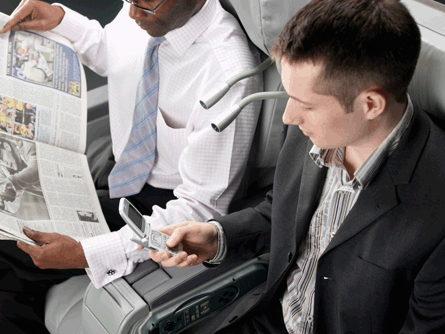Last year was not without its ironies. Even as airlines saw their balance sheets reddened by soaring fuel prices, they made plans to bring in-flight connectivity solutions on board aircraft on a scale never before seen in the industry.
A confluence of factors was at play. The 2006 demise of Connexion, Boeing's popular, yet ultimately flawed Ku-band-based model for airborne internet service, left carriers wary of big investment, yet hungry for alternative systems to meet the growing demands of today's tech-savvy traveller.
In the USA, where the in-flight use of mobile telephones is prohibited, airlines largely turned to Aircell for wireless internet over an air-to-ground (ATG) link, while Alaska Airlines and Southwest Airlines agreed to test Row 44's system, which uses Ku-band capacity more cost effectively than did Connexion. Airlines in Europe and the Middle East found themselves in a race to offer passengers the GSM/GPRS services provided by AeroMobile and OnAir.
At the same time, service providers showed a willingness to work with cash-strapped carriers, often fronting the initial cost of installation in return for revenue generated by their systems. In short order, on-board connectivity became a competitive necessity for airlines.
While 2008 was the year that carriers finally accepted in-flight connectivity as a forgone conclusion, 2009 will be a critical point where airlines seek to deploy a variety of services more broadly across their fleets - wi-fi via Ku-band satellites or an ATG link, and GSM/GPRS over L-band.
 |
|---|
© AeroMobile/Split Image |
Although "a lot of companies will struggle with cashflow in 2009", according to IMDC chief executive Wale Adepoju, the Derby, UK-based consultancy is staying with its prediction that there will be "big uptake of Ku-band, mobile phones on board and continued roll-out of the Aircell ATG system in the USA".
Equipping the world's fleet will not happen overnight, however. "To get from a handful of aircraft [with connectivity] to a huge number is going to take a while," warns Adepoju.
The first carriers to really move on widespread deployment of high-speed internet services outside the USA will be large operators flying transoceanic routes, predicts in-flight entertainment and connectivity consultant Michael Planey.
Since an ATG solution will not work overseas, carriers that want to offer passengers wi-fi will turn to solutions based on Ku-band, such as those being proposed by Panasonic, Row 44 and ViaSat. As yet, only Row 44 has announced trial agreements with carriers.
"If Row 44 can prove that its system works and it has the appropriate approval, they can be in 2009 what Aircell was in 2008," says Planey, who knows of "at least half a dozen carriers" that want this sort of connectivity soon and they are "the big ones you'd expect".
With respect to GSM/GPRS services, Planey believes "you're going to see even more widespread use of cell phone services from OnAir and AeroMobile on the international side, in Europe, the Middle East and Asia".
He warns, however, that some service providers could find themselves short of cash to support installations. "If this was a different time for the economy, I'd have fewer qualms about the roll-out. But the economic problems are hurting. Even the big wealthy carriers you question don't know how much money they'll have to fund some of these projects on their own. In 2009, if the economy stays sour, it could have negative effects on start-up service providers." Conolidation in the sector is likely, although "that probably won't happen until the back end of 2009 or early 2010", says Adepoju, adding: "Who the final service provider is at this point I think is sort of a moving target."
Source: Flight International























